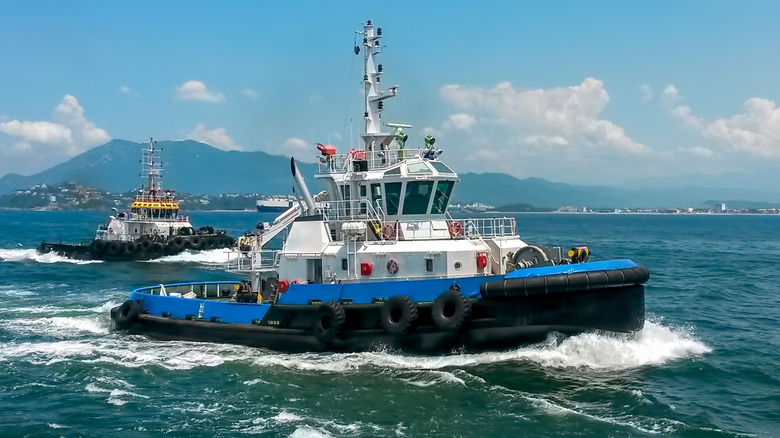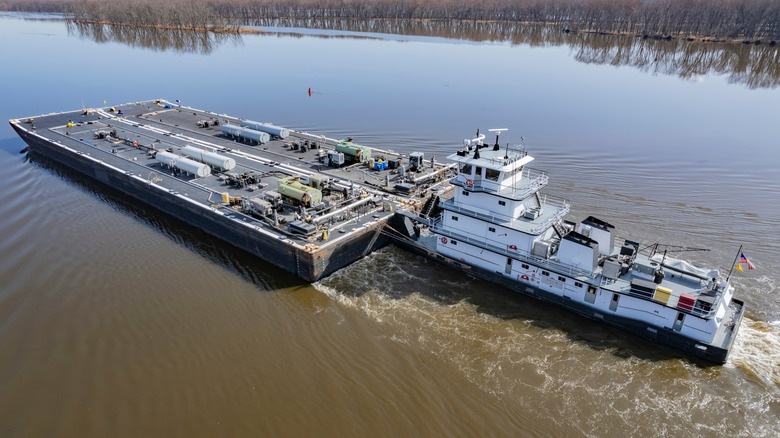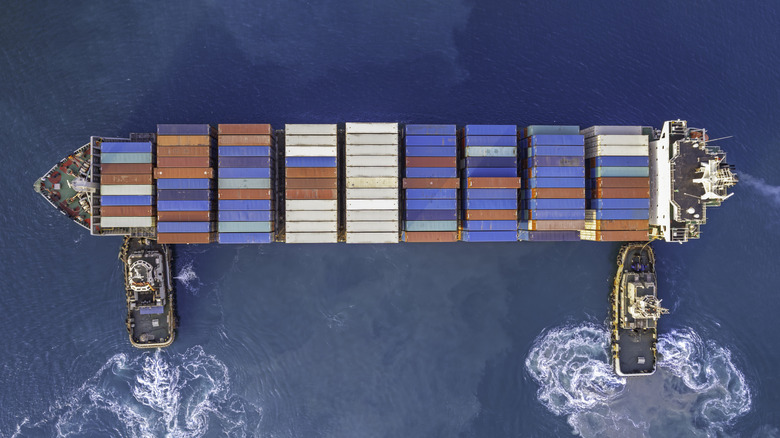Tugboat Vs. Towboat: What's The Difference?
A common misconception among tugboats and towboats is that they are essentially the same. This is understandable given the many similarities between the two, particularly in terms of appearance and the purpose of each watercraft. Compared to other ships, tugboats and towboats are smaller, and both are used to assist other vessels to manoeuvre in certain areas by either towing or pushing them. There are quite a few differences between a tugboat and a towboat; one of the most important is where they operate. Tugboats can function in both rivers and oceans, while towboats are primarily for rivers and inland waterways only.
This divergence in the areas of each ship's operation results from distinct designs for each. A tugboat is constructed with a deep hull, a pointed bow, and deep-water propellers. In contrast, a towboat, also known as a pushboat, is built with a squared-off bow and a flat-bottomed hull, which is best suited for its function of pushing other boats. In addition, there is a marked difference in how they work because, unlike towboats that primarily push other vessels, a tugboat can both push and pull vessels that it is assisting.
In terms of the services they can provide, tugboats are deployed for several roles because they are more capable. Some of the diverse functions of tugboats include towing, anchor handling, marine salvage, icebreaking, survey and research, spraying water while towing, patrolling, firefighting assistance, and as a crew boat. Towboats, on the other hand, have a specific purpose, which is to push and steer barges and other big vessels across inland water bodies.
Push or pull to move ships
Towboats push barges using a unique feature that is installed at the bow, or front, of the ship. Made of high-strength steel with compressed rubber wrapped around them, these structures are called push knees, which are upright, padded beams that are pressed against a ship or barge during the tow. Other connecting elements, including facing wires and headlines, are also used to ensure a stable and rigid connection between the towboat and the barge. This inflexible connection ensures the towboat and the barge can be maneuvered in unison and, because of where it is commonly used, is called the Mississippi Towing Style.
In comparison, tugboats have different ways to pull or push a ship, including direct towing, indirect towing, and pushing. Direct towing is used when a ship or vessel is unable to move by itself, and it requires a tow line to be attached from the ship to the tugboat. For indirect towing, the tow rope is fastened to the stern, or back, of the ship; the tugboat then uses its thrust to maintain a sheered position relative to its heading.
For the pushing method of moving ships, this simply means that the tugboat uses its power to push the ship in the direction it needs to go. To safely push ships, tugboats have a specialized attachment called a marine rubber fender that protects the hulls of both the tug and the ship by absorbing the impact during the tow.
Towing towards the future
Despite their limited use, the towboats' ability to move barges and heavy loads across rivers efficiently makes them a vital component of the inland and coastal shipping industries. This is because towboats act as a link from the ocean to inland waterways by facilitating the movement of cargo that is loaded into barges from the bigger ships, which the towboats then push to their destinations. In the United States, currently, there are 3,761 towboats that provide service for over 22,356 barges, transporting 600 million tons of goods across American inland waterways annually.
On a much larger scale, tugboats function as indispensable ships because of their critical role in the seamless operation of international maritime trade. Tugboats can be found in some of the busiest waterways, ports, and canals. In fact, both the Suez Canal and Panama Canal operate fleets of mighty tugboats to facilitate the movement of container ships and the thousands of containers that pass through them every day.
According to the vessel registration list from the U.S. Coast Guard, there are over 7,000 towing vessels – both tugboats and towboats in the United States. This sizeable number is steadily increasing as shipping companies continue to order more units for their fleet to meet growing demand. At nearly 200 years old, towing vessels continue to be integral to maritime transport and trade and have evolved by using the newest technologies, like hybrid engines and A.I. This adoption of tech on towing ships is part of industry efforts for better efficiency and sustainability, which would ensure the continued relevance of towing vessels into the future.


